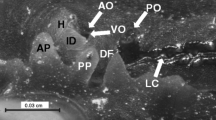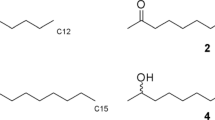Abstract
Messor lobognathus, an apparent mimic ofPogonomyrmex salinus, shows little chemical resemblance to its exemplar. The mandibular glands ofM. lobognathus gave no volatile compounds. Those ofP. salinus contain chiefly 4-methyl-3-heptanone. Both species contain a mixture of straight-chain alkanes, alkenes, and methyl-branched alkanes in their Dufour glands. Tridecane (64%) is the major substance inM. lobognathus and dodecane (25%) and pentadecane (24%) are the major compounds ofP. salinus. No secretion induced trail-following in either species. A mixture of 9-, 11-, and 13-methylheptacosane formed the largest peak in the chromatograms obtained from the postpharyngeal glands of both species, but otherwise the hydrocarbon mixtures in this gland too were distinct.
Similar content being viewed by others
References
Au, M.F., Morgan, E.D., Attygalle, A.B., andBillen, J.P.J. 1987. Comparison of Dufour gland secretion to two species ofLeptothorax ants (Hymenoptera: Formicidae).Z. Naturforsch. 42c:955–960.
Ali, M.F., Billen, J., Jackson, B.D., andMorgan, E.D. 1989. The Dufour gland contents of three species of Euro-AfricanMessor ants and a comparison with those of North AmericanPogonomyrmex (Hymenoptera: Formicidae).Biochem. Syst. Ecol. 17:469–477.
Andrews, H. 1916. A new ant of the genusMessor from Colorado.Psyche 23:81–83.
Attygalle, A.B., andMorgan, E.D. 1986. A versatile micro-reactor and extractor.Anal. Chem. 58:3054–3058.
Bagnères, A.G., andMorgan, E.D. 1991. The postpharyngeal glands and the cuticle of Formicidae contain the same characteristic hydrocarbons.Experientia 47:106–111.
Bagnères, A.G., Bellen, J., andMorgan, E.D. 1991a. Volatile secretion of Dufour gland of workers of an army ant,Dorylus (Anomma) molestus.J. Chem. Ecol. 17:1633–1639.
Bagnères, A.G., Errard, C., Mulheim, C., Joulie, C., andLange, C. 1991b. Induced mimicry of colony odors of ants.J. Chem. Ecol. 17:1641–1664.
Bestmann, H.J., Attygalle, A.B., Glasbrenner, J., Riemer, R., Vostrowsky, O., Constantino, M.G., Melikian, G., andMorgan, E.D. 1988. Pheromones, 65-Identification of the volatile components of the mandibular gland secretion of the antManica rubida: Structure elucidation, synthesis and absolute configuration of manicone.Liebigs Ann. Chem. 1988:55–60.
Billen, J.P.J., Evershed, R.P., Attygalle, A.B., Morgan, E.D., andOllett, D.G. 1986. Contents of Dufour glands of workers of three species ofTetramorium (Hymenoptera: Formicidae).J. Chem. Ecol. 12:669–685.
Billen, J., Attygalle, A.B., Morgan, E.D., andOllett, D.G. 1987a. The contents of the Dufour gland of the antPogonomyrmex occidentalis, pp. 426–427,in J. Eder and H. Rembold (eds.). Chemistry and Biology of Social Insects. Verlag J. Peperny, München.
Billen, J., Attygalle, A.B., Morgan, E.D., andOllett, D.G. 1987b. Gas chromatography without solvents: Pheromone studies: The Dufour gland of the antPogonomyrmex occidentalis.Int. Analyst 1:3–6.
Blum, M.S. 1974. Myrmicine trail pheromones: Specificity, source and significance.J. N. Y. Entomol. Soc. 82:141–147.
Blum, M.S., Padovani, F., Curley, A., andHawk, R.E. 1969. Benzaldehyde: Defensive secretion of a harvester ant.Comp. Biochem. Physiol. 29:461–465.
Bolton, B. 1982. Afrotropical species of the myrmicine ant generaCardiocondyla, Leptothorax, Melissotarsus, Messor andCataulacus (Formicidae).Bull. Br. Mus. (Nat. Hist.) Entomol. Ser. 45:307–370.
Blomquist, G.J., Nelson, D.R., andde Renobales, M. 1987. Chemistry, biochemistry and physiology of insect cuticular lipids.Arch. Insect Biochem. Physiol. 6:227–265.
do Nascimento, R.R., Billen, J., andMorgan, E.D. 1993. The exocrine secretions of the jumping antHarpegnathos saltator.Comp. Biochem. Physiol. 104B:505–508.
Gregg, R.E. 1955. The rediscovery ofVeromessor lobognathus (Andrews).Psyche 62:45–52.
Holldobler, B. 1971. Homing in the harvester antPogonomyrmex badius.Science 171:1149–1151.
Hölldobler, B., andWilson, E.O. 1970. Recruitment trails in the harvester antPogonomyrmex badius.Psyche 77:385–399.
Jackson, B.D. 1991. Chemical studies of volatiles from exocrine secretions of ants. PhD thesis. Keele University. 246 pp.
Jackson, B.D., Wright, P.J., andMorgan, E.D. 1991. Chemistry and trail-following of a harvester ant, pp. 109–112,in I. Hrdy (ed.). Insect Chemical Ecology. Academia Prague, and SPB Academic Publishing, The Hague.
Lockey, K.H. 1988. Lipids of the insect cuticle: Origin, composition and function.Comp. Biochem. Physiol. 89B:595–645.
McGurk, D.J., Frost, J., Eisenbraun, E.J., Vick, K., Drew, W.A., andYoung, J. 1966. Volatile compounds in ants: Identification of 4-methyl-3-heptanone fromPogonomyrmex ants.J. Insect Physiol. 12:1435–1441.
Morgan, E.D. 1990. Preparation of small scale samples from insects for chromatography.Anal. Chim. Acta 236:227–235.
Morgan, E.D., Hölldobler, B., Vaisar, T., andJackson, B.D. 1992. Contents of the poison apparatus and their relation to trail following in the antDaceton armigerum.J. Chem. Ecol. 18:2161–2168.
Pasteels, J.M., andVerhaeghe, J.C. 1974. Dosage biologique de la phéromone de piste chez les fourrageures et les reines deMyrmica rubra.Insectes Soc. 21:167–180.
Regnier, F.E., Nieh, M., andHölldobler, B. 1973. The volatile Dufour's gland components of the harvester antsPogonomyrmex rugosus andP. barbatus.J. Insect Physiol. 19:981–992.
Shattuck, S.O. 1987. An analysis of geographic variation in thePogonomyrmex occidentalis complex (Hymenoptera: Formicidae).Psyche 94:159–179.
Wheeler, W.M., andCreighton, W.S. 1934. A study of the ant generaNovomessor andVeromessor.Proc. Am. Acad. Arts Sci. 60:341–387.
Wheeler, G.C., andWheeler, J. 1956.Veromessor in North Dakota.Psyche 63:140–145.
Wheeler, G.C., andWheeler, J. 1956.Veromessor lobognathus: Third note.J. Kans. Entomol. Soc. 38:55–61.
Wheeler, G.C., andWheeler, J. 1989. On the trail of the antVeromessor lobognathus.Prairie Nat. 21:119–124.
Yensen, N.P., Clark, W.H., andFrancoeur, A. 1977. A checklist of Idaho ants.Pan-Pac. Entomol. 53:181–187.
Author information
Authors and Affiliations
Rights and permissions
About this article
Cite this article
do Nascimento, R.R., Jackson, B.D., Morgan, E.D. et al. Chemical secretions of two sympatric harvester ants,Pogonomyrmex salinus andMessor lobognathus . J Chem Ecol 19, 1993–2005 (1993). https://doi.org/10.1007/BF00983802
Received:
Accepted:
Issue Date:
DOI: https://doi.org/10.1007/BF00983802




